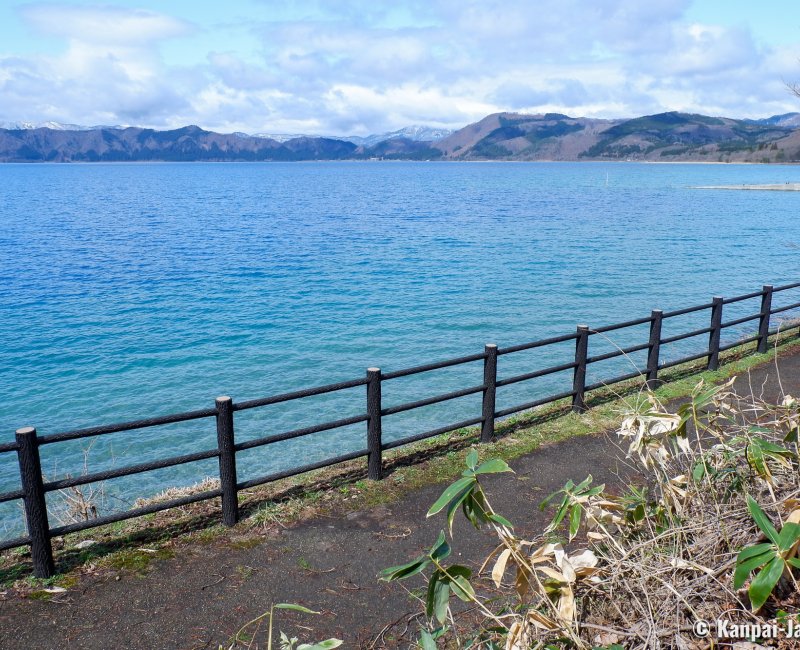Lake Tazawa
Japan’s Deepest Lake
Tazawa-ko is a mountain lake in the heart of Semboku City’s territory, which also includes Kakunodate feudal town, located in the center-east of Akita prefecture in the north of Japan. The lake’s blue, very deep waters have a mystical aura to them and are part of a spectacular natural landscape.
Lake Tazawa’s natural and picturesque beauty was enlisted in the 100 Landscapes of Showa Era Japan (日本百景 Nihon Hyakkei). Located in the Towada-Hachimantai National Park, its main characteristic is its 423,4 meters depth, that makes it the deepest lake in Japan and the 17th in the world. Its surface is located at a 249-meters altitude, and Tazawa-ko’s bottom lies 174 meters below sea level. There, scientists have found 2 lava domes: one in the south of a 300 meters diameter and another one in the north-west of 1-kilometer diameter, from which they concluded the lake was formed by old volcanic eruptions.
Reaching Lake Tazawa by public transport is possible in two steps:
- Take the train to Tazawako station on the Shinkansen 🚅 line connecting Morioka to Akita and passing by Kakunodate, then,
- Take the bus to Tazawa Kohan bus stop to reach its shores.
The various sites are scattered around the lake. A touristic bus running a loop and stopping 10 to 20 minutes at each remarkable sight is available. On summer days, it is also possible to cruise on the lake.

Kansagu shrine and Tatsuko’s statue
In the south-west of the lake, from Katajiri bus stop you can reach:
- Mount Katamae Forest Park, where you get an elevated view on the surroundings,
- The lovely Kansagu shrine, also named Ukiki-jinja; and,
- The statue of Tatsuko, one of the place’s symbols.
Kansagu shrine is dedicated to a large piece of driftwood that is said to have appeared 2 meters above the lake’s surface before sinking into the depths of its waters. A narrow boardwalk circles around the Shinto pavilion and allows to get close to the lake for a beautiful unobstructed view.
Nearby, standing on its stone base, the golden statue of a young woman shines under the sun. Appearing like a Greek or Roman goddess, she is named Tatsuko, and is melancholily staring at the water of Tazawa-ko.

The legend of Tatsuko
A long time ago, in the neighboring town of Innai, lived Tatsuko, a young woman of an extraordinary beauty. One day, as she went to the shore of Tazawa-ko lake to draw water, she saw her reflection in a mysterious rock that shone like a stone mirror (鏡石 kagami-ishi). She saw how beautiful she was, but she also realized her beauty was only ephemeral. She then started to spend her nights praying Okura Kannon, the deity of mercy and compassion.
For her perseverance, the deity granted Tatsuko the location of a sacred source that could provide her the eternal youth. She drank the pure water, but she could not stop at a few sips and ended drying up the source before being transformed into a dragon. When she realized it, she threw herself into the lake and has since become the guardian of its waters.
It is also said that his lover Hachiro, a dragon living in the depths of the neighboring Hachiro-gata lake on Oga peninsula, comes to visit her each autumn 🍁 and stays with her throughout the winter. This legend explains why Lake Hachiro-gata freezes each winter, when its guardian is away, whereas Lake Tazawa, despite being at a higher altitude and therefore colder, doesn’t freeze.
The golden statue on the shore of the lake, made by famous sculptor and paintor Funakoshi Yasutake (1912 - 2002), pays an everlasting tribute to Tatsuko’s youthful beauty.

Goza-no-ishi shrine and its great torii gate
Then, going north to Tazawa-ko, another viewpoint is worth stopping. With its feet at the edge of the water and facing the lake, the great vermilion torii ⛩️ gate indicates the grounds of Goza-no-ishi Shinto shrine extending on the other side of the road.
Near the ablution pavilion, another statue of Tatsuko pictures the young girl transforming into a dragon. The site indeed, is sheltering the sacred source named Katagashira-no-reisen that Tatsuko completely drank before becoming a legendary creature. A small secondary shrine built in 1911 is dedicated to her. This is also the place where you will find the stone mirror kagami-ishi.
Goza-no-ishi also displays a flat stone where Satake Yoshitaka (1609 - 1672), daimyo lord of the times’ Akita domain, sat to admire the lake when he traveled in the area.

Shirahama, the white sand beach
During summertime, Shirahama beach 🏖 is famous for its bright stretch of white sand that harmonizes with the sapphire blue waters of Tazawa-ko lake. It offers a relaxing weekend getaway at the camping and a place for nautical activities such as pedal-boat or rowboat. It is possible to swim in summer in a grandiose natural landscape surrounded by Akita’s high mountains and forest.
The banks of the lake are very few urbanized with a handful of seasonal hotels 🏨 and offer a pleasant walk all year long, including in winter when the snow covers the paths.

Importance of the seasons
Both a nature and mystical destination, lake Tazawa is better enjoyed during the warmer season, from late April to early November, and especially in summer for swimming and camping on its shores. It is also its high touristic season with the most visitors and all shops and seasonal establishments are open.
Off season, there is no proximity service, but the landscape is still beautiful, with the snow covering the shores of the lake and the Shinto pavilions. While the bus network is operating all year round, there are fewer connections and we recommend to check thoroughly the bus schedules beforehand.
From Kakunodate, the visit at Tazawa-ko can be for example completed with an excursion to Mount Hachimantai and a night at a thermal resort of the area such as Nyuto Onsen ♨️ or Tamagawa Onsen.

